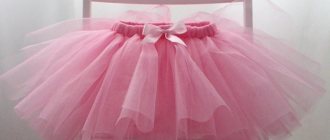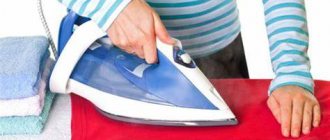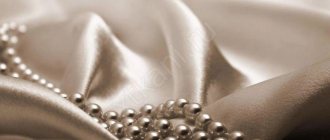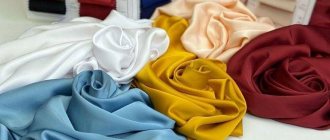Natural silk began to be produced in ancient China. The entire process was manual.
Only noble and rich people could afford clothes made from such fabric. Over time, the secret of fabric production became known in Japan, India, Korea, and then throughout the world.
To ensure that silk items always look beautiful and neat, you need to properly care for them. This fabric requires not only delicate washing, but also ironing. How to iron silk without ruining its appearance?
How to iron silk
Various types of silk materials are used in clothing production today. How the fabric will withstand ironing depends on the composition and quality of the fibers. Therefore, before you pick up the iron, you need to carefully read the recommendations on the label.
It is best to prevent clothes from becoming wrinkled from the beginning: do not leave them crumpled, straighten them immediately after washing, and do not press them down in the closet with other things. And, of course, you need to know how to properly iron silk products.
Features of drying silk
In this process, it is also necessary to adhere to certain conditions. Recommendations for drying silk products are as follows:
- Fold the product in several layers.
- Press gently on both sides with your hands.
- Place a terry towel on a horizontal surface.
- Place a silk item on it - the towel will absorb any remaining moisture.
- Place the item to dry.
Note:
Blouses, dresses and skirts made of this material are hung on hangers so that they do not stretch. Never twist or stretch silk!
Vertical steaming
Items with folds, complex cuts or large sizes are best not ironed, but treated with steam. Movements should be fast and uniform. At the same time, you should not focus the steam on one place for too long. Otherwise, water stains will appear on it, and the item will have to be washed.
Silk steaming process:
- place clothes on hangers, hang them on a hook or bar;
- straighten out all the details and folds;
- attach the attachment for delicate fabrics to the steamer;
- test steam in an inconspicuous area;
- From a distance of 6-7 cm, process the product, moving from top to bottom.
Leave the ironed product to “rest” for several hours. It is not recommended to put it on immediately to prevent the silk from becoming wrinkled again.
Ironing temperature for fabrics – what should you consider?
At what temperature should you iron cotton and other fabrics? Today you can find smart equipment on sale that has many different functions, greatly simplifying the ironing process. You just need to set the desired mode according to the type of fabric and the iron will set the temperature itself. But in any case, you need to be careful - even if you lose vigilance for a short time when ironing clothes, the housewife can ruin a beautiful new thing.
But, in addition to following the instructions included with the iron, you need to pay attention to the ironing marks on the clothes. The characteristics of modern fabrics are almost impossible to determine by touch: without looking at the label, you can confuse cotton with synthetics. Fabric with the addition of synthetic threads, ironed with an iron whose temperature is set to work with a cotton item, will be hopelessly damaged.
Good to know
What to do if you don’t have an iron at hand and you urgently need to go to a business meeting? Our article will tell you how you can iron things without an iron as quickly and safely as possible for the fabric.
Chiffon is a very delicate material that requires the most careful handling. That is why we decided to tell you how to iron chiffon so as not to burn or spoil the fabric.
Hot bath for silk
To iron complex-style clothes, you need professional equipment. At home, it will be replaced by hot steam treatment. A small silk item can be ironed using a kettle:
- hang clothes in a well-lit place;
- boil the kettle;
- Treat bruises with hot steam from the spout.
If the method does not work, then you need to hang the item over the bathroom, close the door and hood, and turn on the hot water. Make sure that splashes do not get on clothes. When the bath is full, close the tap. Keep clothes above water until wrinkles disappear. If necessary, drain the cooled water and add hot water. Leave ironed clothes on a hanger until completely dry.
How to tidy up cotton and linen items
Almost no one has a question at what temperature to iron cotton or linen: you need to set the maximum value on the relay and you can start working. But the fabric, unassuming at first glance, is quite difficult to smooth out, always remaining slightly wrinkled. How to avoid this effect?
It is important to know: steaming is the only way to properly iron a cotton or linen product.
It is equally important to set the temperature correctly:
- 100% cotton should be ironed at a temperature of 150 to 200 degrees, with powerful steaming or spraying water with a spray bottle;
- cotton is diluted with polyester - in this case, the ironing temperature is no more than 110 degrees, the amount of steam and water is limited to a minimum;
- The material contains cotton and linen threads - the relay is set to 180-200 degrees, and the item is generously moistened with water.
Linen can only be exposed to very high temperatures - up to 230 degrees. The product is ironed from the front side, so you must be careful not to burn the item.
Steam generator
If you have a steam generator, then it is better to iron the silk with it than with an iron. Even if the latter has a vertical steam function. The steam generator has a gentler effect on delicate tissue and, accordingly, does not injure the fibers. In addition, when treated with hot steam, the slightest dirt disappears and allergen particles remaining on clothing are destroyed.
To iron silk clothes, you need to:
- fill the steam generator tank with water;
- turn on the “silk” mode;
- process clothes.
Before work, you need to make sure that the steam generator does not leave wet marks on clothes. To do this, iron a spare scrap or similar fabric. If water stains remain, adjust the device so that when ironing you do not ruin your expensive item.
Setting the iron mode
Silk mode must be set. If it is absent, the temperature is set to 120 °C or a division is established between o and “Wool”. If the fabric is thick or ironing is done through gauze, the iron may be a little hotter.
To prevent damage to the material, you need to check the heated sole on the edge of the underside. If the selected area becomes wrinkled or “broken,” the temperature needs to be reduced. Another option is to use gauze.
Wash
Silk products can be washed in a machine at the appropriate setting (up to 30 ° C), but it is better to wash them by hand. If liquid detergents are used, they must be diluted well in water.
It is recommended to first dissolve the powder in a small amount of water until the grains completely disappear, and then add it to a basin or machine. Natural silk also washes well with mild hair shampoo, baby soap or baby powder.
Note! It is prohibited to bleach silk with bleach, since the structure of the fibers is destroyed after treatment. The material quickly becomes unusable.
When washing, do not rub, twist or pull the fabric too much. In addition, silk items should not be soaked for a long time - a maximum of 10 minutes. It is better to dry silk clothes in a shaded place, away from radiators and other heat sources.
How to avoid wrinkles?
To make the fabric wrinkle less, you need to follow some care rules:
- Wash .
You can use an automatic machine (mode for delicate fabrics) or do it manually (at a water temperature no higher than + 30 degrees). It is not recommended to use powder; it is replaced with liquid products that are thoroughly diluted with water. Another taboo is bleach. Chlorine quickly corrodes delicate fibers. - Spin .
Silk should not be twisted. The washed item is hung on hangers and gently rubbed over it with both palms to allow excess water to drain. Until the product dries completely, place it on a thick towel, which will absorb the remaining moisture, and then return it to the trempel. On the clothesline, the fabric will stretch and wrinkles will form.
If you couldn't avoid creases
In this case, the folk method will help:
- 25 ml of glycerin are dissolved in 5 liters of water;
- a silk product is placed in a container, then, without squeezing, hang it up and wait until it dries naturally;
- then the item must be ironed using one of the above methods.
This method is suitable for both natural and synthetic fabrics.
Spin
Silk items do not tolerate intensive twisting or line drying. Do not hang out immediately after washing. The structure of natural fibers is destroyed, which leads to deformation and rapid wear of products.
After washing, clothes should be wrapped in a towel or cotton fabric and blotted. Replace absorbent material. Spread a dry towel, lay the product on it, first straightening out the parts and folds, and leave for a while. Hang the dried item on hangers.
At what temperature should you iron wool?
The temperature for ironing wool is 180 degrees. The material needs moisture even more than cotton fabric. The disadvantage of high-quality and expensive woolen items is that they are prone to rapid deformation and loss of shape. Lack of proper care leads to compression or stretching of the material. Therefore, iron them inside out using a cloth soaked in water, preventing the iron from sliding on the fabric.
It is important to know: information on ironing woolen items can be found in the instructions for the iron; the main thing is not to forget that only woven woolen clothing can be ironed. Knitted items should not be ironed as they may stretch and lose their shape.
Ironing
It is recommended to iron the products while damp. If the item is very dry, then before ironing clothes made of natural silk, it must be moistened.
You should absolutely not spray silk items with a spray bottle, otherwise water marks will remain.
The product must be wrapped in a damp (not wet!) towel or sheet. Place the package in a plastic bag and close it tightly. Leave for a couple of hours. During this time, the silk will dampen well, making it easier to iron. The method will not work if it is “overcooked” in too hot water during washing.
- Products made from dark material must be processed from the inside out, light items from the front side.
- Acetate silk does not tolerate high temperatures and strong pressure. It is recommended to iron with dampness through cotton fabric.
- Lining fabrics are processed from the wrong side.
- Fabrics made from raw silk should be ironed with a dampened hot iron on the reverse side.
- Artificial silk items are ironed at moderate temperatures. For severe creases, use a moderately heated iron.
Features of silk fabric
Silk is one of the oldest textile fibers and was used in China more than 4,500 years ago. Natural silk consists of fibers woven by silkworms. Silkworm caterpillars, turning into chrysalises, are entwined with silk, from which fibers are obtained. They are used to make scarves, dresses, bed linen and other clothing items. To keep silk always soft, smooth and durable, you need to follow some basic rules when washing, ironing and storing it.
Silk items are washed by hand in cool water with hand and delicate items added. This way you will maintain the softness and original color of the silk.
- It is necessary to place a piece of silk fabric in a bowl of cold water, add the required amount of detergent, and allow the product to dry.
- After which you should rinse it thoroughly and drain the water without twisting it.
Never wring out silk clothing to get rid of excess water, as this may damage the item. If necessary, blot it with a clean, absorbent towel.
Do not under any circumstances use a clothes dryer on silk clothes. This type of fabric should be allowed to air dry. And if possible, avoid using hooks to hang silk clothes, as this will inevitably leave a mark on the fabric.
Useful tips for caring for silk
Before ironing, you need to make sure there are no stains. If there are any, then it is better to entrust complex stains to dry cleaning. The rest can be dealt with with home remedies:
- traces of sweat disappear if you wipe them with a cotton swab dipped in alcohol.
- white material will not turn yellow for a long time if vinegar (hydrogen peroxide, ammonia) is added to the last rinse.
- A paste of water and crushed aspirin tablets will help whiten stains.
To prevent iron marks from appearing when ironing, you need to use the “silk” mode. The soleplate of the iron must be clean, free of carbon deposits and stuck particles. A special cleaning pencil or a paste of soda and water (1:2) will help clean the surface. It is applied for a few minutes, then removed, and the sole is wiped.
If severe bruises remain after washing, then before ironing, you need to soak the clothes for several minutes in water with glycerin (25 ml of product per 5 liters). Afterwards, carefully pat dry with a towel and dry flat on a soft surface. This method is suitable for natural and acetate silk.
Things to consider
Silk fabric is delicate and needs to be ironed under special conditions. If the products are made of high-quality material, they do not wrinkle at all and therefore do not need to be ironed. Usually, expensive accessories are made from such high-quality fabrics - neckerchiefs, scarves, blouses, dresses. In order for the products to have an aesthetic appearance, it is enough to dry them after washing in a straightened form, laying them out on a perfectly flat surface.
If you have silk items, check out the useful recommendations from experts on how to iron natural silk:
- You should start the ironing process without waiting for the product to dry completely. Experts do not recommend ironing dry fabric by sprinkling it with water, as drops can leave behind stains and stains. You should also not allow the item to dry out, otherwise it will become rough and hard, and it will not be easy to smooth it out.
- Place a clean cotton cloth on the ironing board for ironing.
- Set the iron to a low temperature, which is used for ironing fabrics containing silk fiber. Modern devices are equipped with the “Silk” temperature mode. If this mode is not available, set the temperature between o and “Wool”, it will be no more than 150 degrees. This is the optimal temperature for ironing silk.
- If you are not sure of the correct temperature setting, carefully move the heated iron in an inconspicuous place. The corner of the product from the wrong side is suitable for this.
- It is not recommended to iron natural material using the steam mode. Since under the influence of hot steam the product may become deformed and lose its color.
- Items made of natural silk should be ironed from the wrong side or from the front, but through dry gauze or thin cotton fabric.
- When ironing, the iron should be moved smoothly over the surface of the fabric. It is important not to stay in one area for too long, otherwise you risk burning expensive material.
- Sometimes it happens that the product has dried unevenly; in hard-to-reach places and in the seam area, the fabric may be wet at the time of ironing. In this case, a metallic sheen may appear on the material. Only repeated hand washing and drying naturally will help correct the situation.
To make silk fabric easy to iron, it is important to wash silk items correctly:
- products made from 100% natural silk can only be washed by hand washing;
- for washing you should use special soft products intended for delicate items;
- the water temperature should not exceed 30 degrees;
- It is also important to wring out the washed item carefully; you can lightly wring it out with your hands and hang it up so that the water drains off on its own.
With such actions, after drying, there will be no traces of wrinkles and creases on the fabric, which are often difficult to remove even when ironing silk.
Please note: There is such a variety of this smooth material as “wild silk”, or tussah. It differs in that it has an unusual weave of fibers. It needs to be ironed differently - only dry and on the reverse side. The iron must be set to the lowest temperature setting.
We steam the folds, maintaining the quality of the product
First of all, we need to hang a silk item in the bathroom.
To do this, you need to turn on a hot shower, and then let the steam thoroughly treat the product. It is the steam that will help smooth out wrinkles. We suggest using a hand steamer. The silk outfit should be hung up. Then you should run the hand steamer from top to bottom several times to get rid of unsightly wrinkles. Pay attention to the instructions for use, because it also happens that your steamer has special nuances that are important to follow.
Interesting to know! Silk threads are used as a surgical suture material in the treatment of wounds and various injuries.











